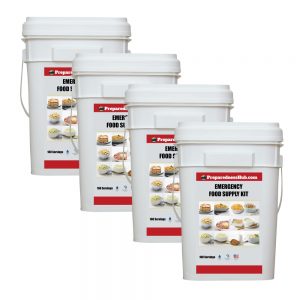 When you put your 72 hour kit/bug out bag together, most contain the obvious-food and water, ways to stay warm, dry, treat injuries, hygiene supplies, and such. But there are a few items that are not in most kits, which most of us don’t think about, but can make a big difference in our comfort and safety. Here are five that I bet most of you don’t have in your bag. (Kudos if you beat me to the punch)
When you put your 72 hour kit/bug out bag together, most contain the obvious-food and water, ways to stay warm, dry, treat injuries, hygiene supplies, and such. But there are a few items that are not in most kits, which most of us don’t think about, but can make a big difference in our comfort and safety. Here are five that I bet most of you don’t have in your bag. (Kudos if you beat me to the punch)
Plastic sheeting and duct tape
I do see duct tape from time to time in kits, but a large piece of sheeting-a whole role in the basement or under the bed would be even better-can cover a broken window in a hurricane or after a tornado, serve as a tarp over supplies or gear that shouldn’t get wet, be an emergency tent, or cut into smaller pieces for ponchos.
A shovel
Survivalbased.com sells a good one here: http://www.survivalbased.com/survival-gear/tools/deluxe-tri-fold-shovel-w-cover.html
, or there are plenty of others to choose from. But for digging latrines, or digging through rubble, your hands or a small trowel won’t cut it.
Pet Food & Supplies
Two thirds of us own a pet at home. Do you have pet food in your 72 hour kit? Are you planning to keep Fido satisfied with your extra beef jerky? Think again. People food is not dog or cat (or ferret or parakeet or whatever) food. Pets need to have their own supply. An emergency will be a stressful time for them anyway, having food they are used to eating will help keep them in good health. Pet food does not keep as long as dehydrated/freeze dried human food, be sure to rotate it on a regular basis.
Eye wear
Whether you sport spectacles or usually wear contact lenses, an extra pair of glasses is one item I always keep in my kit. Getting through an emergency is tough enough when you can see, but if your glasses are lost or broken, or you don’t have access to eye drops for contact lenses, not seeing clearly is a problem you just don’t need. As an aside, a pair of polarized sunglasses, prescription or drugstore, is a smart addition.
Communication
This final item can be an either or, but a second way to make contact with the outside world besides a cell phone is something you should have. If your cell phone works, great. But if the power is out, it may be out to local cell towers, rendering you incommunicado. And it’s a guarantee that whatever network is running will be flooded with calls. So another way to let loved ones know that you are OK is more than a good idea. The old fashioned solution is a corded phone. The hard wired phone network from days of yore carries its own power supply. And remember, your cordless phone relies on electricity, so if the power is out, you need to plug right into the wall. The 21st century solution is a “Satellite Messenger”, like the SPOT Communicator ®. It uses a network of satellites to let people know you are OK and where you are, or to summon emergency aid to your location. Other similar devices exist-a bit pricier-that allow you to send and receive text messages using the same network. The one heads up about the messenger devices is that while they are not too expensive to buy-the latest base model of the SPOT runs about $110, all of them have monthly or annual subscription fees that run from $100 and up, up, to $600 per year. Over time, that would add up, so if you go this route, use that little guy. Take it hiking, on road trips, anywhere you might be stuck without a cell signal. Devices called Personal Locator Beacons also are available, they are more expensive, but have no subscription fee. However, current PLB models do only one thing-summon help. So an “I’m OK” message won’t work.

 Emergency Food Supply Kit - 536 Servings (4 pack)
Emergency Food Supply Kit - 536 Servings (4 pack)